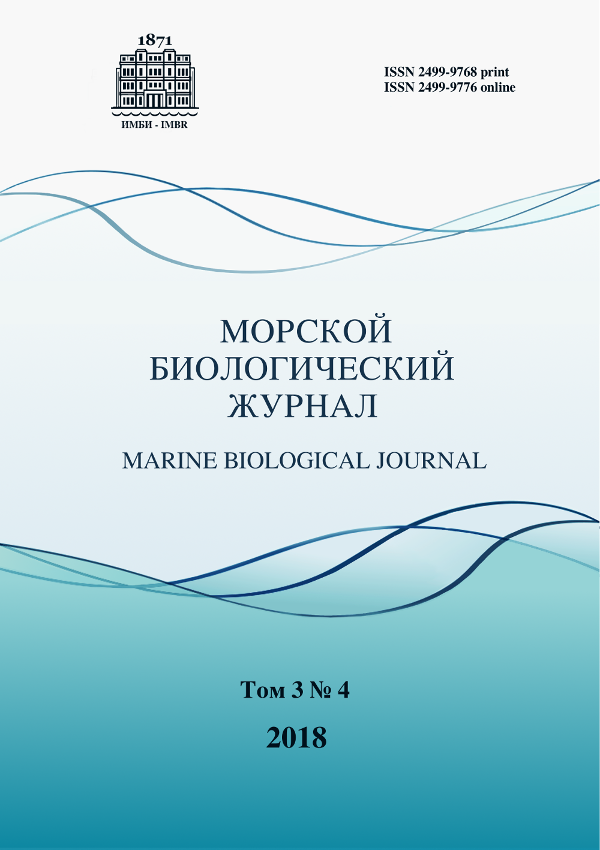The copper content in the organs and tissues of Mytilus galloprovincialis Lamarck, 1819 and the flow of its sedimentary deposition into bottom sediments in the farms of the Black Sea aquaculture
##plugins.themes.ibsscustom.article.main##
##plugins.themes.ibsscustom.article.details##
Abstract
The role of mussels in formation of water chemical composition is determined by the peculiarities of sorption and trophodynamic processes. Copper is a vital element, but of ten metals the toxic effect of which was tested for the survival of mussel and oyster embryos, copper is following mercury. Studying the regularities of copper content change during mussel ontogeny allows to determine both sanitary and hygienic risks of mussel product use during the mollusks cultivation in mariculture and the biogeochemical role in the formation of the chemical composition of the marine water near mussel farms. The purpose of this work is to determine the copper content in the organs and tissues of the mussels during seasonal course of mollusks ontogenesis, to analyze the degree of copper assimilation along the food path of mineral nutrition using the mathematical model and empirical data and to assess the influence of marine farms on the copper exchange processes in the coastal ecosystem. The mollusks were collected from the mussel farm located in the external roadstead of Sevastopol. Studying the copper content in the environment – mussel – biodeposition system, a method of atomic absorption spectroscopy with electrothermal atomization was used. A general model illustrating the process of copper exchange between the mussels and the water environment is presented. Equations for determining the degree of assimilation of metal from food (q) and the limiting coefficient of food accumulation of metal (Кп) are proposed based on the results of measurements of its concentrations in the mussels’ diet, soft tissue and their biodeposition without using radioactive trace elements. The values of the copper removal by the mussel farm were calculated. The role of cultivated mollusks in the heavy metals precipitation was shown.
Authors
References
Доценко И. В. Оценка осаждения тяжелых металлов черноморской мидией (Mytilus galloprovincialis Lam.) в морских акваториях : автореф. дис. … канд. геогр. наук : 25.00.23. Ростов-на-Дону, 2005. 25 с. [Dotsenko I. V. Otsenka osazhdeniya tyazhelykh metallov chernomorskoi midiei (Mytilus galloprovincialis Lam.) v morskikh akvatoriyakh : avtoref. dis. … kand. geogr. nauk : 25.00.23. Rostov-na-Donu, 2005. 25 p. (in Russ.)].
Нормативы качества воды водных объектов рыбохозяйственного значения, в том числе нормативы предельно допустимых концентраций вредных веществ в водах водных объектов рыбохозяйственного значения. Утв. приказом Федерального агентства по рыболовству от 18.01.2010, № 20. 215 с. [Normativy kachestva vody vodnykh ob”ektov rybokhozyaistvennogo znacheniya, v tom chisle normativy predel’no dopustimykh kontsentratsii vrednykh veshchestv v vodakh vodnykh ob”ektov rybokhozyaistvennogo znacheniya. Utv. prikazom Federal’nogo agentstva po rybolovstvu ot 18.01.2010, no. 20. 215 p. (in Russ.)].
Патин С. А. Влияние загрязнения на биологические ресурсы и продуктивность Мирового океана. Москва : Пищевая промышленность, 1979. 250 с. [Patin S. A. Vliyanie zagryazneniya na biologicheskie resursy i produktivnost’ Mirovogo okeana. Moscow : Pischevaya promyshlennost’, 1979, 250 p. (in Russ.)].
Печень-Финенко Г. А. Фильтрационная активность мидий в условиях Севастопольской бухты // Гидробиологический журнал. 1992. Т. 28, № 5. С. 44–50. [Pechen-Finenko G. A. Filtration activity of mussels under conditions of the Sevastopol Bay. Gidrobiologicheskij zhurnal, 1992, vol. 28, no. 5, pp. 44–50. (in Russ.)].
Поликарпов Г. Г., Егоров В. Н. Морская динамическая радиохемэкология. Москва : Энергоатомиздат, 1986. 176 с. [Polikarpov G. G., Egorov V. N. Morskaya dinamicheskaya radiokhemekologiya. Moscow : Energoatomizdat, 1986, 176 p. (in Russ.)].
Попов Н. И., Федоров К. Н., Орлов В. М. Морская вода. Москва : Наука, 1979. 327 с. [Popov N. I., Fedorov K. N., Orlov V. M. Morskaya voda. Moscow : Nauka, 1979, 327 p. (in Russ.)].
Поспелова Н. В., Копытов Ю. П., Нехорошев М. В. Простой способ подготовки проб для анализа содержания тяжёлых металлов в системе «взвесь – мидии – биоотложения» методом атомной абсорбции // Учёные записки ТНУ. Сер. «Биология, химия». 2006. Т. 19 (58), № 1. С. 156–160. [Pospelova N. V., Kopytov Yu. P., Nekhoroshev M. V. Prostoi sposob podgotovki prob dlya analiza soderzhaniya tyazhelykh metallov v sisteme “vzves’ – midii – biootlozheniya” metodom atomnoi absorbtsii. Uchenye zapiski TNU. Ser. “Biologiya, khimiya”, 2006, vol. 19, iss. 58, no. 1, pp. 156–160. (in Russ.)].
Саенко Г. Н. Металлы и галогены в морских организмах. Москва : Наука, 1993. 252 с. [Saenko G. N. Metally i galogeny v morskikh organizmakh. Moscow : Nauka, 1993, 252 p. (in Russ.)].
Таможняя В. А., Горомосова С. А. Биохимические показатели метаболизма мидий при действии на них токсинов // Экология моря. 1985. Вып. 21. С. 64–68. [Tamozhnyaya V. A., Goromosova S. A. Biochemical indices of mussel metabolism under the toxin effect. Ekologiya morya, 1985, iss. 21, pp. 64–68. (in Russ.)].
Финенко Г. А., Романова З. А., Аболмасова Г. И. Экологическая энергетика черноморской мидии // Биоэнергетика гидробионтов / ред.: Г. Е. Шульман, Г. А. Финенко. Киев : Наукова думка, 1990. С. 32–72. [Finenko G. A., Romanova Z. A., Abolmasova G. I. Ekologicheskaya energetika chernomorskoi midii. In: Bioenergetika gidrobiontov / G. E. Shul’man, G. A. Finenko (Eds). Kiev : Naukova dumka, 1990, pp. 32–72. (in Russ.)].
Цихон-Луканина Е. А. Трофология водных моллюсков. Москва : Наука, 1987. 176 с. [Tsihon-Lukanina E. A. Trofologiya vodnykh mollyuskov. Moscow : Nauka, 1987, 176 p. (in Russ.)].
Bryan G. W. Heavy metals contamination in the sea. In: Marine pollution / Johnston R. (Ed.). London ; New York ; San-Francisco : Academic Press, 1976, ch. 3, pp. 185–302.
Pirkova A. V., Stolbova N. G., Ladygina L. V. Seasonal dynamics of spawning of Mytilus galloprovincialis on muddy biotopes in areas of the Black Sea. Oceanographic Literature Review, 1996, vol. 43, no. 4, pp. 398.
Robinson W. E., Ryan D. K., Wallace G. T. Gut contents: A significant contaminant of Mytilus edulis whole body metal concentrations. Archives of Environmental Contamination and Toxicology, 1993, vol. 25, no. 4, pp. 415–421. https://doi.org/10.1007/BF00214329.
Wallner-Kersanach M., Lobo S. E., Da-Silva E. M. Depuration effects on trace metals in Anomalocardia brasiliana (Gmelin, 1791). Bulletin of Environmental Contamination and Toxicology, 1994, vol. 52, no. 6, pp. 840–847. https://doi.org/10.1007/BF00200692.


 Google Scholar
Google Scholar



